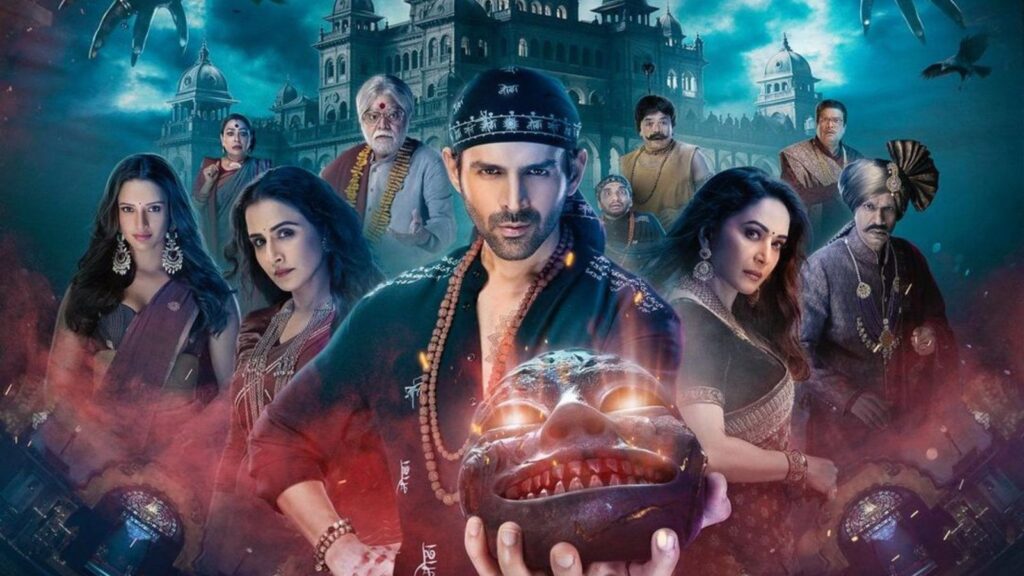Bhool Bhulaiyaa 3, a standalone additional to the Bhool Bhulaiyaa franchise directed by Anees Bazmee, attempts to blend humour with horror with a landscape entangled in lies, deceptions, thrills, comical and ghostly situations. Sadly, the film fails to excite or engage as it should, undermining its potential for genuine frissons and laughs.
Ruhan, aka Rooh Baba (Kartik Aaryan), is a masquerader who deceives people out of their money by claiming to be a parapsychologist. He comes across a young woman, Meera (Triptii Dimri), and her maternal uncle (Rajesh Sharma), who capture his fraudulent act on a mobile phone. They blackmail him into joining them in selling their haunted ancestral property in the fictional village of Rakht Ghat in Bengal to prospective buyers. Lured by money and the fear of being exposed, Ruhan agrees. Upon reaching the village, Ruhan realizes he resembles Prince Debendranath, the prince of the kingdom from 200 years ago. According to urban legend, the mansion is haunted by the ghost of Princess Manjulika, who was mercilessly burned alive on the orders of her father (Denzil Smith). Meera introduces Ruhan to her impoverished family as a sorcerer who will free the mansion from the spirit and help them make money by selling the place. With renewed hope, as the family returns to the mansion, they encounter supernatural situations leading them to unexpected revelations. Things get more complicated when two mysterious women – Mallika (Vidya Balan), who enters the palace as a restorer, and Mandira (Madhuri Dixit), who is interested in purchasing the property at a steep price – enter the plot.
Though Bhool Bhulaiyaa 3 has on an idea level an entertaining plot that ticks all the right boxes, it lacks depth in fleshing out its characters and situations. The screenplay stretches on as more and more characters are introduced, seemingly to fill gaps left by underwritten scenes. This excess only succeeds in prolonging and dragging the story, while the clichéd use of Bengali phrases is a cheap attempt to elicit laughter. Scenes of characters being possessed are presented ridiculously, relying on tired tropes to generate fear. Even Meera’s growing affection for Ruhan happens so suddenly that it feels unearned, lacking the development needed to make their connection believable. The final moments of the film, where it takes a transgressive turn, is portrayed so amateurishly and unconvincingly that it feels more like going back rather than being progressive.
The opportunity to feature actresses like Madhuri Dixit and Vidya Balan together is instantly appealing but the screenplay by Aakash Kaushik fails to provide them with substantial material to shine. Even the dance face-offs between their characters fizzle out despite a beautiful soundtrack. Bazmee’s direction also feels underwhelming as it cannot fully harness the acting prowess of these two talented actresses. That they still steal the show speaks of their charisma and talent.
Kartik Aaryan brings a lively energy to Ruhaan to gamely try and carry the film through. Triptii Dimri, as Meera, doesn’t get too much opportunity to showcase her talent. She’s primarily reduced to being Ruhan’s necessary love interest with only a few fleeting moments where her potential shines through. The makers lean more into her objectification, emphasizing her physical appeal and prioritizing appearance over characterization. In supporting roles, Vijay Raaz, Rajpal Yadav, Sanjay Mishra, Ashwini Kalsekar, and Rajesh Sharma are given room to rise above their caricatured characters.
Manu Anand’s cinematography effectively captures the eerie atmosphere of the film while the sound design by Manas Choudhury and the background score by Aggi Agnelo Fernandes both manage to provide some scope for genuine jump scares. Sanjay Sankla’s editing struggles against the film’s sluggish pace, more the result of uninspired writing. . The song sequences feel forced – except for Ami Je Tomar – and appear added mainly to create a music album for T-Series, the producer.
It is a pity that with so many resources at its disposal, Bhool Bhulaiyaa 3 comes across as little more than a formulaic entry to the franchise. Truth be told, none of the films in the series come remotely close to the original source, the classic Malayalam film Manichitrathazhu (1993) – a must-watch for those who haven’t seen it.
Hindi, Horror, Comedy, Color


